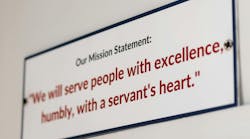In an interview, “The One Minute Manager” author Kevin Blanchard spoke of a scenario where an employee was at a bowling alley. At the end of the lane there was a curtain and a supervisor of the employee with a clipboard. The pins were not visible to the employee but there was the belief that there were pins behind the curtain and they would be set up like a normal bowling set would be.
The employee rolls the ball down the lane and can hear that pins are hit but has no idea of how many or which ones he hit. The manager examines the pins, writes the result on the clipboard and instructs the employee to roll again. The manager feels that he has complete control over the game because he knows what happened. However, because of his controls and lack of feedback, he was almost guaranteed that the employee would blindly hurl the ball down the lane depending on luck for success.
This scenario seems pointless, but it is common in your business. The employee understands basic logic and rules and does his best. The manager may notice that the job was not done correctly and tells them to “do it right”. The employee tries again, not knowing how the first attempt was wrong. At the end, everyone becomes frustrated and the game is eventually lost. Had the manager entered an effective feedback model, the game could have been won.
Basics of Feedback
Always ask for permission to give feedback- This allows the employee to let you know if the employee can process criticism right now. If not in an accepting mood, the employee can quickly dismiss the feedback as complaining.
State facts not feelings. This can be tricky but for those who have dated or had kids, it is an all too common situation. If I asked, “When you were mad?” The immediate response will be, “I wasn’t mad. You took it that way.”
Instead of this dance use actual actions, like when you slammed the door or kicked the traffic cone. If you cannot pinpoint actions, you don’t have a good understanding of the situation and should not give feedback.
Explain the effect. Did it upset a customer? Lose us money? Hurt someone? This will vary greatly based on the person and the offense. Take the time to understand the employee’s goals and values and show how this sets them back from those.
Encourage a group resolution. It is not your employees’ role (may not even be in their abilities) to fix a problem. You as the manager must manage the situation and build people for the better. If they could have done it right under their vision they most probably would have. You must walk through and examine it with them and together figure out the best path for them to correct it. If there are people on your team who purposely screw up they should be treated as such and cut from the team immediately.
The final rule is the most important and most missed. Use positive feedback often. Positive feedback should be in the same order as the others. Ask permission, state the situation, state the outcome and congratulate them.
Using only bad feedback is like walking up to the customer with a dirty air filter. “Every time I come in here you try to sell me something!”… get it?
Help Me Help You
Feedback is a gift to your employee. It is a big box wrapped in pretty paper with a bow and a card that says, “I want you to succeed so much that I am willing to tell you your messing up.” You must have the mindset that you are not scolding your employee. You are teaching them how not to lose. If you do not invest into your employees’ development, you are just working with a bunch of losers, and you are leading the loser group.
If you decide that you do not have the time or energy to correct an action, you are telling everyone that this action is now acceptable. When you finally had enough of seeing the bad action, you tend to get mad, lay down the iron fist and have that big huddle with everyone who has now picked up the bad habit. Now your team not only has to be retrained but also process why you are suddenly changing direction, and obviously it’s because they think you are in a bad mood.
While feedback can be uncomfortable at first, quick and precise feedback grows people, keeps operations streamlined and cuts back on downtime. The feedback can take seconds and be extremely effective. I recommend reading Blanchard’s book.





